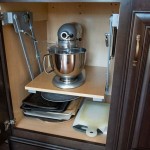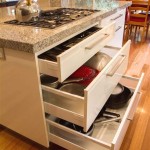How to Install a Kitchen Tile Backsplash
Installing a kitchen tile backsplash is a home improvement project that can significantly enhance the aesthetics and functionality of a kitchen. A well-installed backsplash not only protects the wall from splashes and spills but also adds visual appeal and can increase the value of the home. This article provides a comprehensive guide on how to install a kitchen tile backsplash, outlining the necessary steps and considerations for a successful project.
Planning and Preparation
Before commencing the installation process, meticulous planning and preparation are crucial. This stage involves several key tasks that ensure a smooth and efficient workflow.
1. Measuring and Material Calculation: Accurately measure the area intended for the backsplash. This involves determining the width and height of the space between the countertop and the bottom of the upper cabinets. Multiply these measurements to calculate the total square footage. Add approximately 10-15% to this figure to account for cuts, waste, and potential breakage. This ensures an adequate supply of tile to complete the project without running short.
2. Selecting Tiles: Choosing the right tile is essential for achieving the desired aesthetic. Consider factors such as material (ceramic, porcelain, glass, stone), size, shape, color, and pattern. Ceramic and porcelain tiles are popular choices due to their durability, affordability, and ease of maintenance. Glass tiles offer a sleek and modern look but may require specialized cutting tools. Natural stone tiles provide a unique and luxurious appearance but often require sealing to protect against stains and moisture.
3. Gathering Tools and Materials: Assemble all the necessary tools and materials before starting the installation. Essential tools include a tile saw (wet saw preferred for precise cuts), tile nippers, a notched trowel, a rubber grout float, a grout sponge, a level, a measuring tape, a pencil, safety glasses, and work gloves. Materials required include the selected tiles, thin-set mortar, grout, sealant, spacers, painter’s tape, and a clean bucket.
4. Preparing the Surface: The surface to which the tile will be adhered must be clean, smooth, and structurally sound. Remove any existing backsplash, wallpaper, or loose paint. Scrape away any debris and clean the wall thoroughly with a degreaser to remove grease and grime. Repair any holes or imperfections with patching compound and allow it to dry completely. Sand the patched areas smooth and prime the wall with a suitable primer to ensure proper adhesion of the thin-set mortar.
Tile Installation
With the planning and preparation complete, the tile installation phase can begin. This stage requires careful attention to detail and precise execution to achieve a professional-looking result.
1. Determining the Layout: Before applying any mortar, dry-fit the tiles to determine the optimal layout. Start by finding the center point of the backsplash area and marking it with a pencil. Lay out a row of tiles from the center point outwards, using tile spacers to maintain consistent gaps between the tiles. This will help visualize the final appearance and identify any potential issues, such as awkward cuts or uneven spacing. Adjust the layout as needed to ensure a balanced and aesthetically pleasing arrangement.
2. Applying Thin-Set Mortar: Mix the thin-set mortar according to the manufacturer's instructions. Use a clean bucket and a mixing paddle to achieve a smooth, consistent consistency. Apply a thin, even layer of mortar to the wall using the notched trowel. Hold the trowel at a 45-degree angle and create ridges in the mortar. This creates a better bonding surface for the tiles. Only apply mortar to a small area at a time (approximately 2-3 square feet) to prevent it from drying out before the tiles are set.
3. Setting the Tiles: Press each tile firmly into the mortar, using a slight twisting motion to ensure good contact. Align the tiles carefully, using tile spacers to maintain consistent grout lines. Use a level to ensure that the tiles are perfectly level and plumb. If necessary, tap the tiles gently with a rubber mallet to adjust their position. Wipe away any excess mortar from the tile surface with a damp sponge. Continue setting tiles, working in small sections, until the entire backsplash area is covered.
4. Cutting Tiles: Cutting tiles is often necessary to fit around outlets, windows, or other obstructions. Use a tile saw for straight cuts and tile nippers for irregular shapes. Measure the area to be cut accurately and mark the tile with a pencil. When using a tile saw, guide the tile slowly and steadily through the blade, following the marked line. Wear safety glasses to protect your eyes from flying debris. For small, intricate cuts, use tile nippers to carefully chip away small pieces of tile until the desired shape is achieved. Smooth the cut edges with a rubbing stone to remove any sharpness.
5. Allowing the Mortar to Cure: Once all the tiles are set, allow the mortar to cure completely according to the manufacturer's instructions. This typically takes 24-48 hours. Avoid disturbing the tiles during this period to ensure a strong and lasting bond.
Grouting and Sealing
After the mortar has cured, the next step is to grout the tile joints and seal the backsplash to protect it from moisture and stains.
1. Removing Tile Spacers: Before grouting, carefully remove all the tile spacers from the grout lines. Use a pair of pliers or a utility knife to remove any stubborn spacers. Ensure that the grout lines are clean and free of any debris.
2. Mixing and Applying Grout: Mix the grout according to the manufacturer's instructions. Use a clean bucket and a mixing paddle to achieve a smooth, creamy consistency. Apply the grout to the tile surface using a rubber grout float. Hold the float at a 45-degree angle and spread the grout diagonally across the tile, forcing it into the grout lines. Work in small sections, ensuring that all the grout lines are completely filled.
3. Removing Excess Grout: After applying the grout, wait approximately 15-30 minutes to allow it to set slightly. Then, use a damp grout sponge to remove the excess grout from the tile surface. Rinse the sponge frequently in clean water and wring it out thoroughly. Wipe the tile surface gently, using a circular motion, to remove the grout haze. Be careful not to remove too much grout from the grout lines. Allow the grout to cure completely according to the manufacturer's instructions, typically 24-72 hours.
4. Polishing the Tile: Once the grout has cured, use a clean, dry cloth to polish the tile surface. This will remove any remaining grout haze and enhance the shine of the tile.
5. Sealing the Grout: Sealing the grout is essential to protect it from moisture and stains. Apply a grout sealant according to the manufacturer's instructions. Use a small brush or applicator to apply the sealant evenly to the grout lines. Allow the sealant to penetrate the grout for the recommended time, and then wipe away any excess sealant from the tile surface. Reapply the sealant periodically to maintain its effectiveness.
6. Caulking: Apply a bead of caulk along the edges where the backsplash meets the countertop and the upper cabinets. This will create a watertight seal and prevent water from seeping behind the backsplash. Use a high-quality, mildew-resistant caulk that is specifically designed for kitchen and bathroom applications. Apply the caulk evenly and smoothly, using a caulking gun. Use a wet finger or a caulk smoothing tool to create a clean, professional-looking finish.
Final Touches
With the grouting and sealing complete, a few final touches will complete the backsplash installation project.
1. Installing Outlets and Switch Plates: Carefully reinstall any electrical outlets and switch plates that were removed during the preparation phase. Ensure that the power is turned off at the circuit breaker before working with electrical components. Tighten the mounting screws securely, but be careful not to overtighten them and crack the tile.
2. Cleaning and Inspecting: Give the entire backsplash area a final cleaning to remove any remaining dust or debris. Inspect the installation carefully to ensure that all the tiles are securely bonded, the grout lines are uniform, and the sealant is properly applied. Address any imperfections or issues promptly to prevent them from becoming more significant problems in the future.
By following these steps carefully and paying attention to detail, homeowners can successfully install a kitchen tile backsplash that enhances the beauty and functionality of their kitchen. This project is a rewarding investment that can increase the value and enjoyment of the home.

How To Install A Kitchen Backsplash The Best And Easiest Tutorial

How To Install A Perfect Tile Backsplash All Materials Tools And Prices Included

How To Install A Kitchen Backsplash The Best And Easiest Tutorial

How To Install A Tile Backsplash Part 1 Buildipedia Diy

How To Install A Tile Backsplash Arizona

How To Install Subway Tile Installing Backsplash For The First Time Crafted Workshop

How To Install A Perfect Tile Backsplash All Materials Tools And Prices Included Youtube

How To Install Subway Tile Installing Backsplash For The First Time Crafted Workshop

How To Install A Backsplash Acme Tools

How To Install Tile Backsplash Fixthisbuildthat








